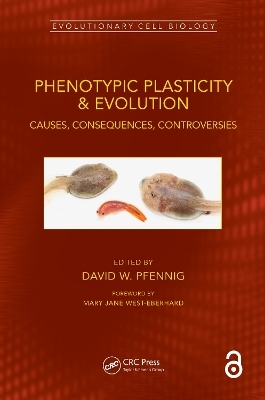
Phenotypic Plasticity & Evolution
CRC Press (Verlag)
978-0-367-35704-7 (ISBN)
Phenotypic plasticity – the ability of an individual organism to alter its features in direct response to a change in its environment – is ubiquitous. Understanding how and why this phenomenon exists is crucial because it unites all levels of biological inquiry. This book brings together researchers who approach plasticity from diverse perspectives to explore new ideas and recent findings about the causes and consequences of plasticity. Contributors also discuss such controversial topics as how plasticity shapes ecological and evolutionary processes; whether specific plastic responses can be passed to offspring; and whether plasticity has left an important imprint on the history of life. Importantly, each chapter highlights key questions for future research. Drawing on numerous studies of plasticity in natural populations of plants and animals, this book aims to foster greater appreciation for this important, but frequently misunderstood phenomenon.
Key Features
Written in an accessible style with numerous illustrations, including many in color
Reviews the history of the study of plasticity, including Darwin’s views
Most chapters conclude with recommendations for future research
David W. Pfennig is a professor of biology at the University of North Carolina, Chapel Hill and a Sigma Xi Distinguished Lecturer. He is broadly interested in evolutionary biology, ecology, behavior, and developmental biology and is author (with Karin Pfennig) of Evolution’s Wedge: Competition and the Origins of Diversity. His work has been featured on The National Geographic Channel, on the BBC/ PBS’s Nature series, and in The New York Times, Newsweek, National Geographic, Scientific American, New Scientist, and Discover, among other publications.
Foreword: A Perspective on Plasticity
Preface and Acknowledgements
Section I Plasticity & Evolution: Concepts & Questions
Phenotypic Plasticity as an Intrinsic Property of Organisms"There is Hardly Any Question in Biology of More Importance"––Charles Darwin and the Nature of Variation
Key Questions about Phenotypic Plasticity
Section II Causes of Plasticity: From Genes to Ecology
Genetic Variation in Phenotypic Plasticity
Physiological Mechanisms and the Evolution of Plasticity
Ecology and the Evolution of Plasticity
The Loss of Phenotypic Plasticity via Natural Selection: Genetic Assimilation
Section III Consequences of Plasticity: Adaptation, Origination, Diversification
Buying Time: Plasticity and Population Persistence
Innovation and Diversification via Plasticity-led Evolution
Plasticity and Evolutionary Transitions in Individuality
Phenotypic Plasticity in the Fossil Record
Section IV Plasticity & Evolution: Controversies & Consensus
The Special Case of Behavioral Plasticity?
Plasticity Across Generations
How Does Phenotypic Plasticity Fit into Evolutionary Theory?
Plasticity and Evolutionary Theory: Where We Are and Where We Should be Going
List of Contributors
Index
| Erscheinungsdatum | 02.06.2021 |
|---|---|
| Reihe/Serie | Evolutionary Cell Biology |
| Zusatzinfo | 23 Line drawings, color; 24 Line drawings, black and white; 11 Halftones, color; 5 Halftones, black and white; 34 Illustrations, color; 29 Illustrations, black and white |
| Verlagsort | London |
| Sprache | englisch |
| Maße | 156 x 234 mm |
| Gewicht | 1043 g |
| Themenwelt | Naturwissenschaften ► Biologie ► Genetik / Molekularbiologie |
| Naturwissenschaften ► Biologie ► Zellbiologie | |
| ISBN-10 | 0-367-35704-6 / 0367357046 |
| ISBN-13 | 978-0-367-35704-7 / 9780367357047 |
| Zustand | Neuware |
| Haben Sie eine Frage zum Produkt? |
aus dem Bereich


